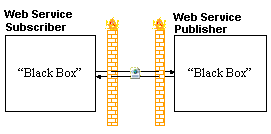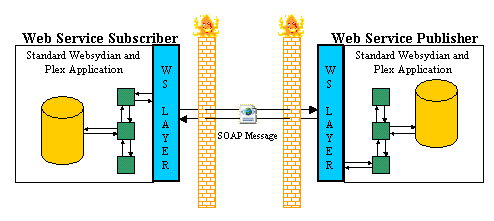|
|
Introduction Implementing Other Uses Parts Tutorial Glossary
WSYSOAP
The TransacXML SOAP pattern supports publishing of SOAP based web services and subscribing to SOAP based web services.
It also offers options for handling XML based web services without the SOAP wrapping.
As shown below a generic web service implementation communicates across the Internet and across firewalls. The party initiating a web service dialog is called the Subscriber, while the party accepting requests is called the Publisher. Seen from the outside, both the Subscriber and the Publisher are implemented as "Black Boxes".

The Websydian TransacXML Developer enables development of both parties involved in a Web Service. In the example below both parties are implemented using Websydian TransacXML Developer.

TransacXML adds a Web Service Layer to standard Websydian applications, allowing developers to Web Service enable existing applications or develop new Web Service applications from scratch.
If you are going to call a web service that is provided by another party, you will only create the subscriber part. If you are going to provide a web service for other parties to call, you will only create the publisher part.
A thorough description of the SOAP standard is outside the scope of this document. But it is still important that you have some information about the standard.
As the standard is not easily understood, a better start might be an explanation of the standard, for example:
Before a web service is implemented it must be taken into consideration whether to use the DWA or the CWA architecture in Websydian. For more information about CWA and DWA please refer to the following documents:
Websydian TransacXML supports SOAP 1.1 and WSDL 1.1.
The soap standard defines four different forms of message formats and styles. For a short introduction to these see SOAP Messaging Formats.
In general, we highly recommend that you use document/literal if you are in a position to decide which form to use.
Document/literal is the most flexible of the formats and the one that in leads to the fewest compatibility problems.
However, in some cases you need to call a RPC-based service. To make this possible TransacXML provides the option to import a RPC-based WSDL file. This creates the XML definitions necessary for you to call the service.
As you in most cases will have control of the format when you provide the service, the CreateWSDL function always generates document/literal WSDL definitions.
In more detail - TransacXML supports the four formats as follows:
Generation of WSDL is supported.
Publishing services is supported.
WSDL import is supported.
Calling services is supported.
Not supported.
This format seems not to be used by anyone - and it is not clear what it should be used for.
Generation of WSDL is not supported.
Publishing services is supported.
WSDL import is supported.
Calling services is supported.
Generation of WSDL is not supported.
Publishing services is supported.
Calling services is supported.
We have created a small number of background documents that contains information about specific problem domains.
Understanding the implementation of namespaces in XML in general is one of the areas that often provides serious challenges.
Some of the most common problems relates to the meaning and handling of the namespace declarations found in XML documents. The following document contains a simplified explanation of these declarations.
The implementation of namespaces in TransacXML is described in the following document.
When creating XML applications you will very often either have to be able to produce a W3C XML Schema describing your XML documents - or WSDL files describing the web services you provide. In other cases an external partner will provide either a W3C XML schema for an XML document you must be able either create or read - or a WSDL file describing a web service you must be able to call.
The creation of W3C XML schemas for XML documents defined in TransacXML is described in this document.
The creation of WSDL files based on a TransacXML implemented web service is described in the following document.
The import of an W3C XML schemas and/or WSDL files into TransacXML is described here: